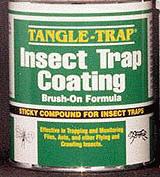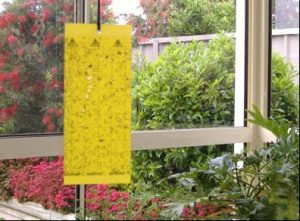Years ago when I first started in my pest control career, I had to make my own glue boards. It was sort of like when I was a short order cook, things were pretty sloppy until I got the hang of it. You didn’t want a sandwich from me. I’d mash it, put 2 tons of mayonnaise on it, tear the bread and just really made a mess. Good thing I switched careers.
Now days of course you can buy all sorts of sticky traps to catch just about anything; roaches, mice, white flies, rats, spiders and the list goes on and on. So why make them? Well in today’s economy you may find it cheaper and you can also custom make your traps to fit your unique situation.
 First let’s talk about what kind of glue to get. Anything that dries of course is out of the question so put the Elmer’s back in the drawer. Several brands of glue are available such as Tangle foot, Tack Trap and Catch master. They come in small or large containers and have all the directions. Most any do it yourself pest control store will have it or you can easily find it on line. I’ve even used aerosol spray glue and done alright with it but it does dry out after a few days. You can also make your own glue material if you are so inclined. A quart of water and a quart of corn syrup mixed up and brought to a boil will make a nice sticky glue you can use. Petroleum jelly works rather well and some folks I’ve heard use old motor oil but I really think that’s a bit much.
First let’s talk about what kind of glue to get. Anything that dries of course is out of the question so put the Elmer’s back in the drawer. Several brands of glue are available such as Tangle foot, Tack Trap and Catch master. They come in small or large containers and have all the directions. Most any do it yourself pest control store will have it or you can easily find it on line. I’ve even used aerosol spray glue and done alright with it but it does dry out after a few days. You can also make your own glue material if you are so inclined. A quart of water and a quart of corn syrup mixed up and brought to a boil will make a nice sticky glue you can use. Petroleum jelly works rather well and some folks I’ve heard use old motor oil but I really think that’s a bit much.
Now that you have your sticky of choice, choose what to put it on to catch your prey. If you’re after White flies or Aphids use bright yellow construction paper or cardboard. They are attracted to the color and you’ll fill up the trap in no time. For a mouse you might choose a small pizza or shoe box. Simply cut out an entry hole on both sides. For smaller insects like roaches and crawling insects it’s as simple as a piece of paper, cardboard or just about anything small and disposable. Use your imagination and you can tailor your sticky trap to fit any situation.
White flies or Aphids use bright yellow construction paper or cardboard. They are attracted to the color and you’ll fill up the trap in no time. For a mouse you might choose a small pizza or shoe box. Simply cut out an entry hole on both sides. For smaller insects like roaches and crawling insects it’s as simple as a piece of paper, cardboard or just about anything small and disposable. Use your imagination and you can tailor your sticky trap to fit any situation.
To apply the glue you need a plastic spoon or knife coated with liquid soap. (Not much, just a thin layer) You may need a sturdier tool like a butter knife or scissors if you buy the gallon size glue to scoop out what you need and cut it. These tools also need to be coated with soap. Then simply lay the glue on your trap and spread it around. A very thin layer is all that’s needed for insects but go a little thicker for rodents.
 Now all you need is to place the sticky and wait for your bug. If he isn’t as cooperative as you like you can smear some peanut butter in the center of the trap or a piece of fruit might work as well. For flying insects simply punch a hole in the top of your trap and hang it with string or secure it to a popsicle stick and place it in the soil of your planter.
Now all you need is to place the sticky and wait for your bug. If he isn’t as cooperative as you like you can smear some peanut butter in the center of the trap or a piece of fruit might work as well. For flying insects simply punch a hole in the top of your trap and hang it with string or secure it to a popsicle stick and place it in the soil of your planter.
If you make extra sticky traps for later, you can size and cut out a piece of wax paper to place over the glue until you’re ready to use it. The paper will peel back easily and you’re in business.
The traps you make won’t be perfect but they’ll be just as effective as any store bought brand and the sealed container of glue should stay good for years of future use.
So have fun, keep the cat away while you’re making your traps; I’m kind of hungry, I think I’ll go make myself a sandwich.




